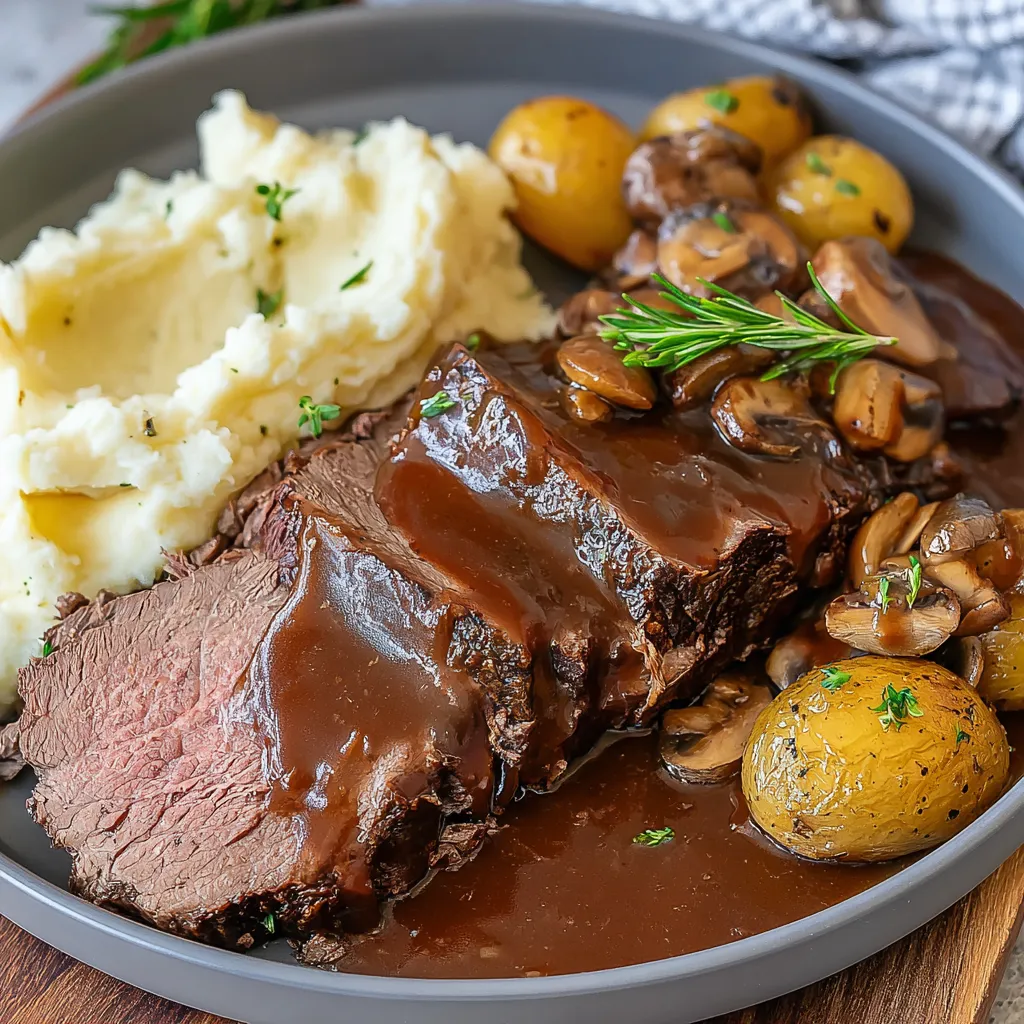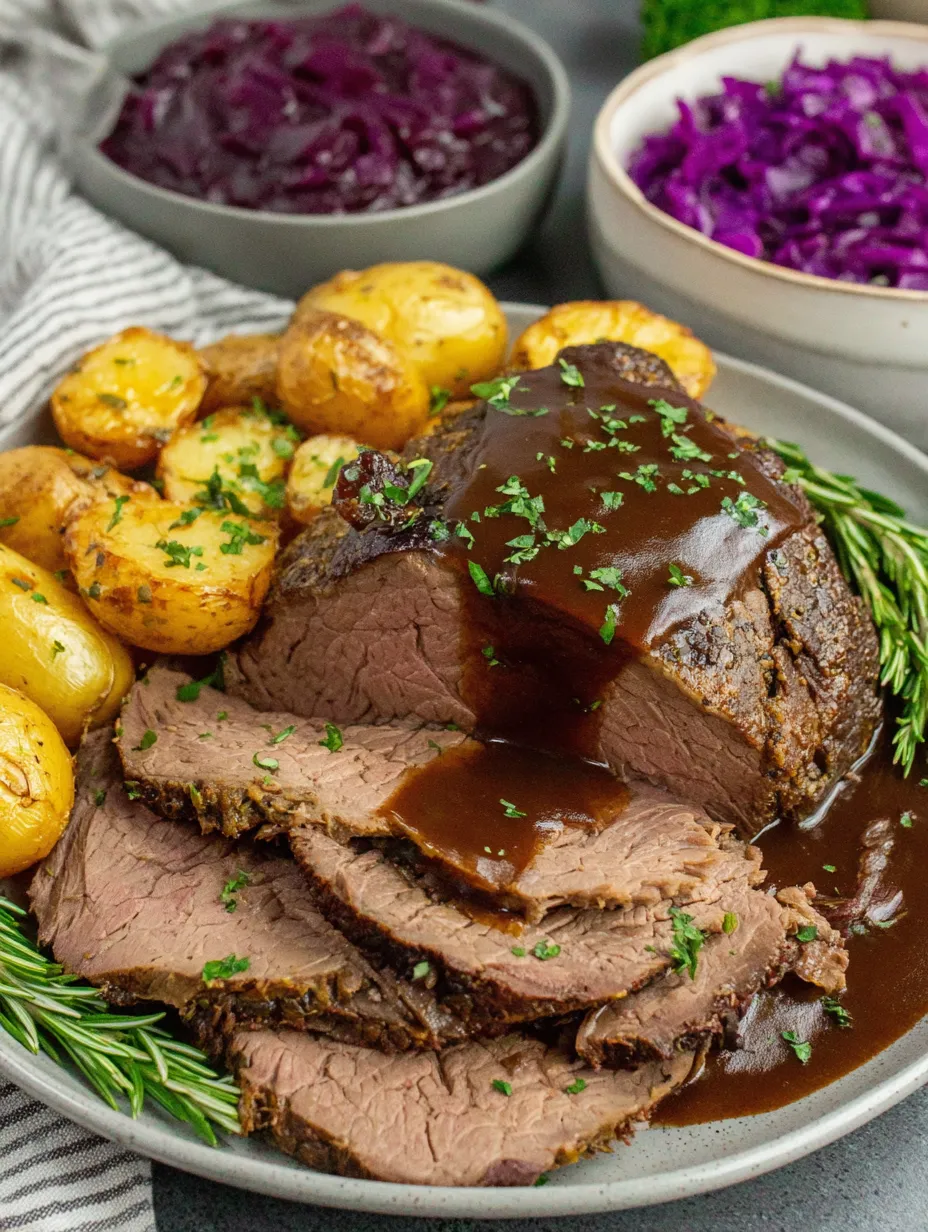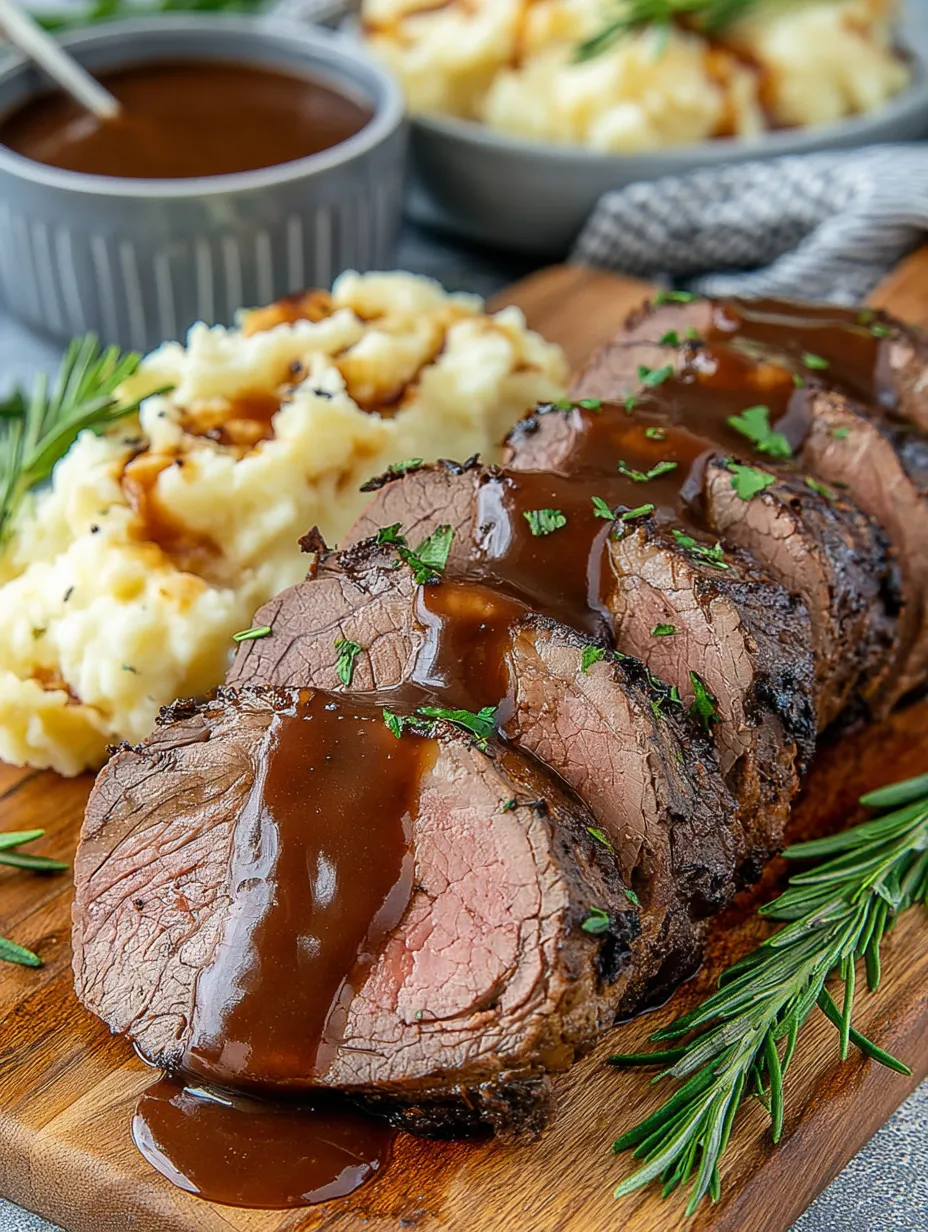 Pin
Pin
This traditional sauerbraten has been at the heart of many festive family gatherings in my home. With fork-tender beef slowly braised in a fragrant, tangy marinade, it is the kind of dish that turns a regular weekend or holiday into a true event.
My kids know it as the meal Grandma makes when company is coming and everyone eagerly gathers for second helpings. There is something comforting about the aroma that fills the kitchen after a long marinate and slow simmer.
Ingredients
- Red wine vinegar or apple cider vinegar: adds a necessary tang to tenderize the beef and give the marinade its signature flavor. Always use a vinegar with a bright clean smell for the best results.
- Water: blends with the vinegar and helps mellow the acidity so that the roast is flavorful without being sharp.
- Large onion sliced: brings gentle sweetness and body to the marinade
- Garlic minced: gives depth and a subtle kick. I always choose firm cloves without green sprouts for their milder flavor.
- Sugar: rounds out the sharp edges of the vinegar and balances the spices
- Bay leaves, whole cloves, whole allspice, and black peppercorns: combine for the classic German spice profile. Buy whole spices if you can and slightly crush them before using to help them release their oils.
- Three to four pounds beef rump roast or chuck roast: is best. Choose a cut with good marbling which results in juicy tender slices after the long cook. Chuck roast is often easier to find and works just as well.
- Vegetable oil: for searing and developing a deep flavorful crust. Neutral oils are best to avoid overpowering the spices.
- Crushed gingersnap cookies: for the gravy are the old world touch that makes the sauce warm and distinctive. Look for cookies that are firm and spicy rather than very sweet.
- Beef broth: for extra meatiness in the sauce. You can blend with chicken broth if desired for complexity.
- Butter and flour: are combined for a classic roux to thicken the gravy and lend a shiny finish.
Step-by-Step Instructions
- Marinate the Beef:
- Combine vinegar water onion garlic sugar bay leaves cloves allspice and peppercorns in a large bowl. Place the beef in a nonreactive dish and completely submerge it in the marinade. Cover tightly and refrigerate for three to five days turning the meat at least once daily to ensure even marinating.
- Sear the Roast:
- Pat the marinated beef dry with paper towels. Heat vegetable oil in a heavy pot or Dutch oven over medium high until shimmering. Add the meat and brown each side in the hot oil for about four to five minutes per side. This creates the flavorful crust essential for a good sauerbraten.
- Simmer Until Tender:
- Pour the entire marinade over the browned beef along with the beef broth. Bring the mixture slowly to a simmer. Lower the heat cover and cook gently for about three hours. The beef is ready when it yields easily to a fork and is deeply infused with the marinade flavors.
- Make the Gravy:
- Remove the beef from the pot and cover to keep warm. Strain the cooking liquid to remove solids and return the liquid to the pot. Bring to a gentle simmer and stir in the crushed gingersnaps. In a separate small bowl mash butter and flour together to form a paste. Gradually whisk this paste into the simmering liquid and cook until the sauce is thick silky and coats the back of a spoon about five minutes.
- Serve with Sauce:
- Slice the beef thinly across the grain and arrange on a warm serving platter. Pour the hot gravy over the slices to soak every piece. Sauerbraten shines with traditional potato dumplings or tangy braised red cabbage on the side.
 Pin
Pin
Gingersnap cookies are my secret weapon here. Their subtle spiciness sets this gravy apart and reminds me of my grandmother who never wrote the recipe down but always had those cookies handy in her pantry.
Storage Tips
Once the sauerbraten has cooled completely slice the leftover roast and cover with remaining gravy. Store in an airtight container in the fridge for up to four days. The flavors develop more overnight so do not hesitate to prepare ahead for best results. To freeze wrap beef and sauce separately for up to two months and reheat slowly so the meat remains tender.
Ingredient Substitutions
If you prefer less tangy flavor use apple cider vinegar instead of red wine vinegar and add an extra half teaspoon of sugar. Chuck roast makes an excellent substitute for rump and is generally easier to find. For a gluten free version swap crushed gluten free gingersnaps and use a cornstarch slurry to thicken the gravy rather than flour and butter.
 Pin
Pin
Serving Suggestions
Serve sauerbraten with classic sides such as potato dumplings spaetzle or buttery mashed potatoes. Braised red cabbage adds gentle sweetness that balances the acidic beef. I love to finish the plate with a few crisp dill pickles or a spoonful of tart applesauce for a true German touch.
Cultural and Historical Context
Sauerbraten has roots deep in German culinary history and was originally created as a way to tenderize tough cuts of beef through long marination. Each region in Germany puts its own spin on the marinade spices and even side dishes. For many families including mine it is still a go to dish for holidays and memorable Sunday suppers.
Recipe FAQs
- → What cut of beef is best for traditional Sauerbraten?
Look for rump roast or chuck roast as these cuts become tender and flavorful after extended marinating and slow cooking.
- → How long should the beef marinate for maximum flavor?
Ideally, marinate the beef for 3 to 5 days in the refrigerator, turning occasionally to allow even flavor absorption.
- → Can apple cider vinegar replace red wine vinegar?
Yes, apple cider vinegar is a suitable alternative that lends a slightly sweeter tang to the marinade.
- → Why use gingersnap cookies in the gravy?
Crushed gingersnaps help thicken the sauce and add warm, aromatic spice notes that complement the rich beef.
- → What are the best sides to serve with Sauerbraten?
Potato dumplings, mashed potatoes, or braised red cabbage are classic accompaniments that soak up the savory gravy beautifully.
- → How do you achieve a smooth gravy?
Strain the sauce before adding gingersnaps and roux to remove solids, then whisk well for a velvety consistency.
